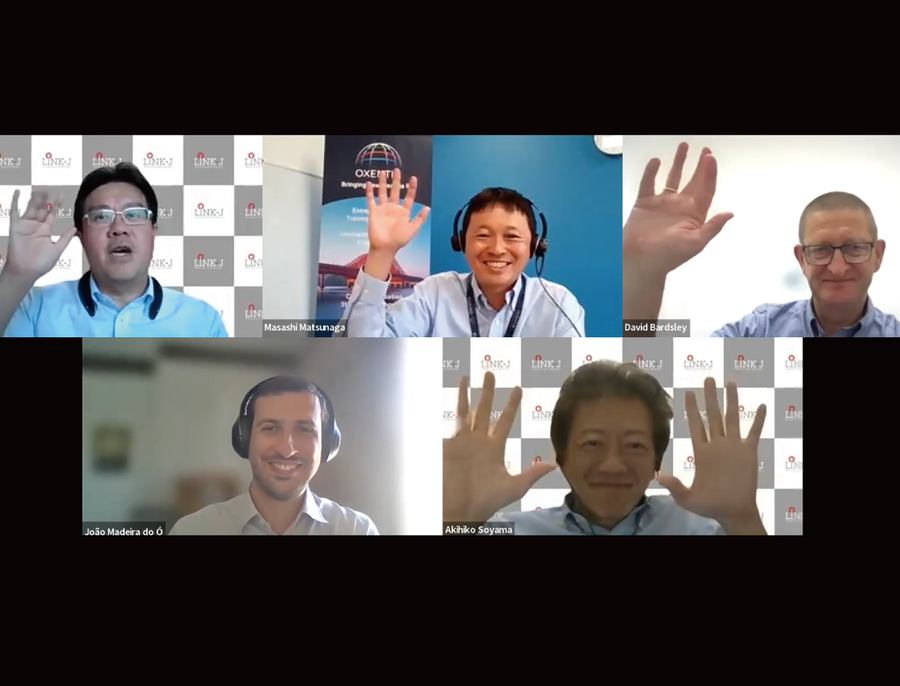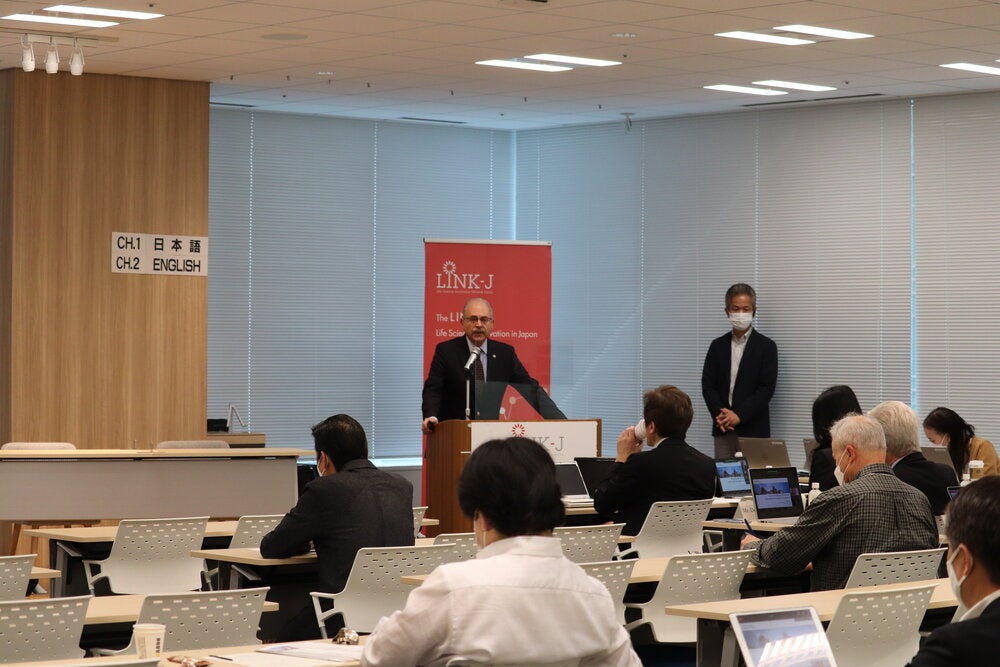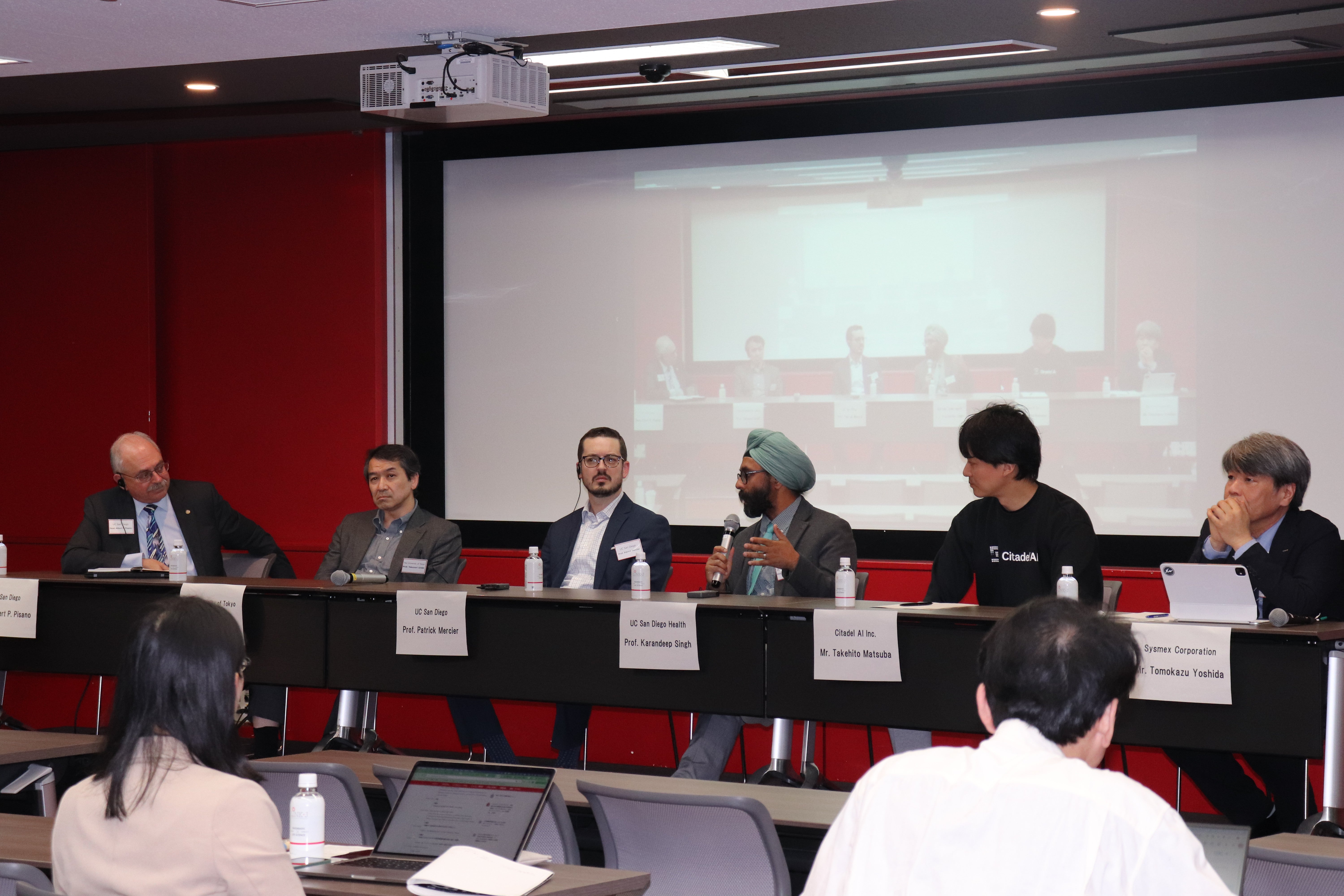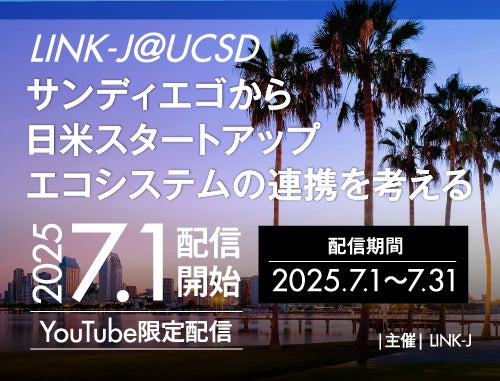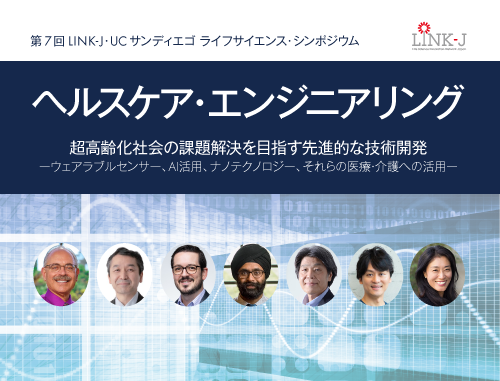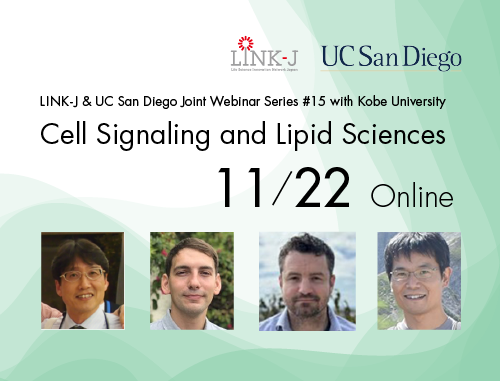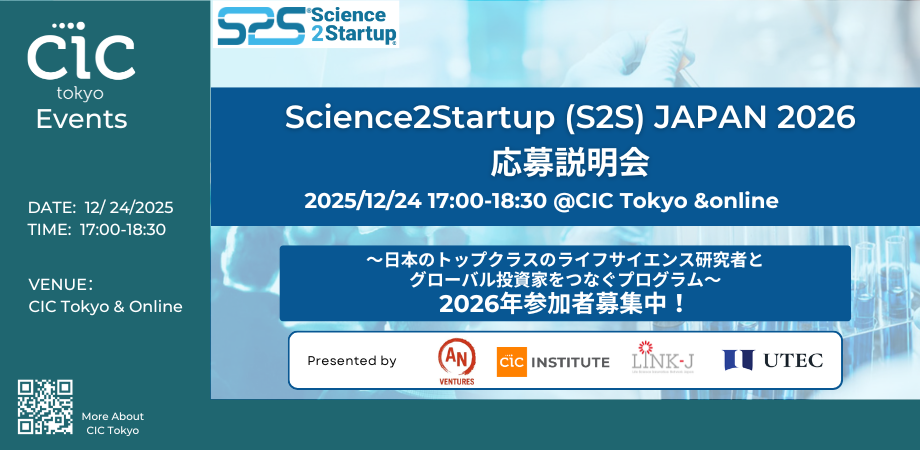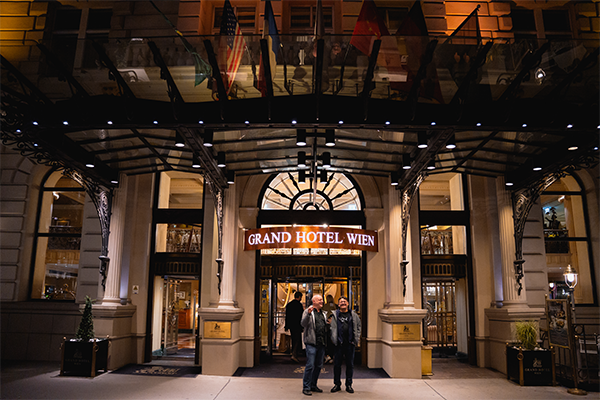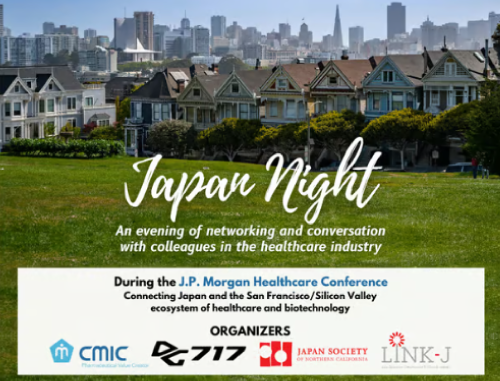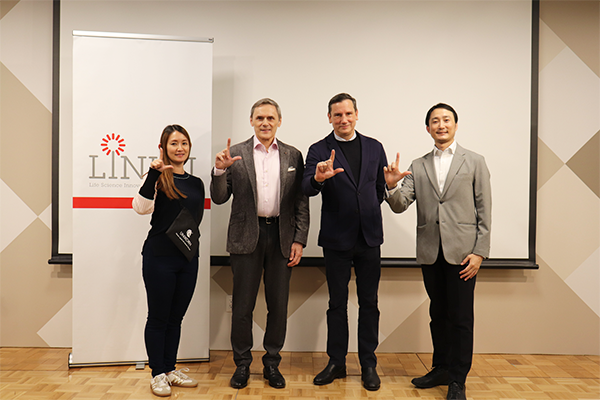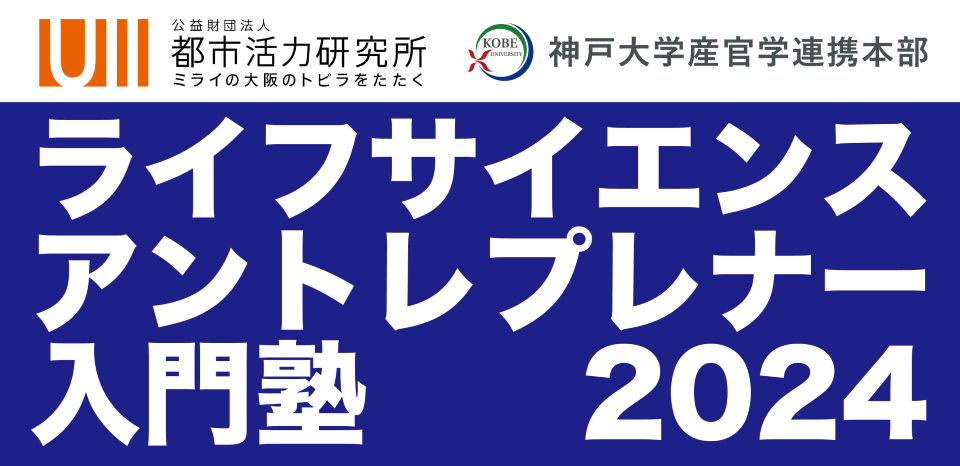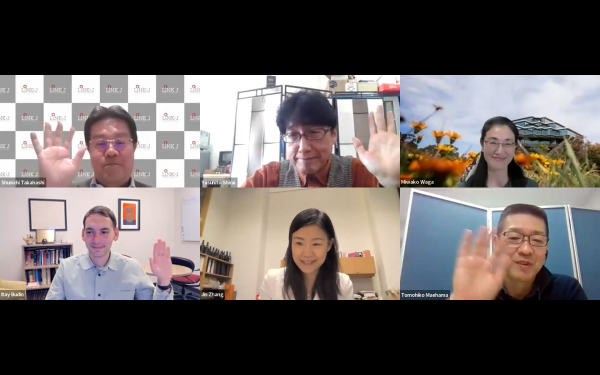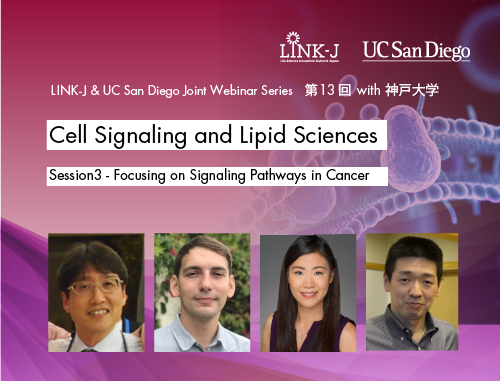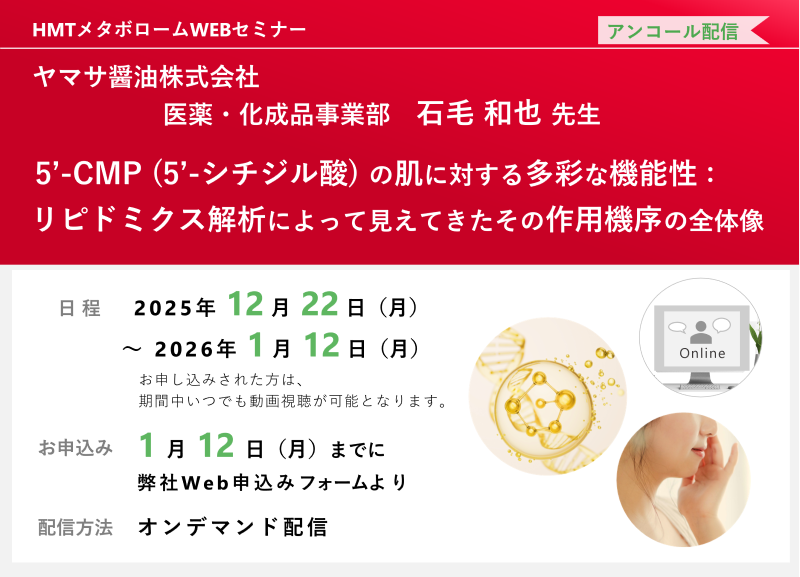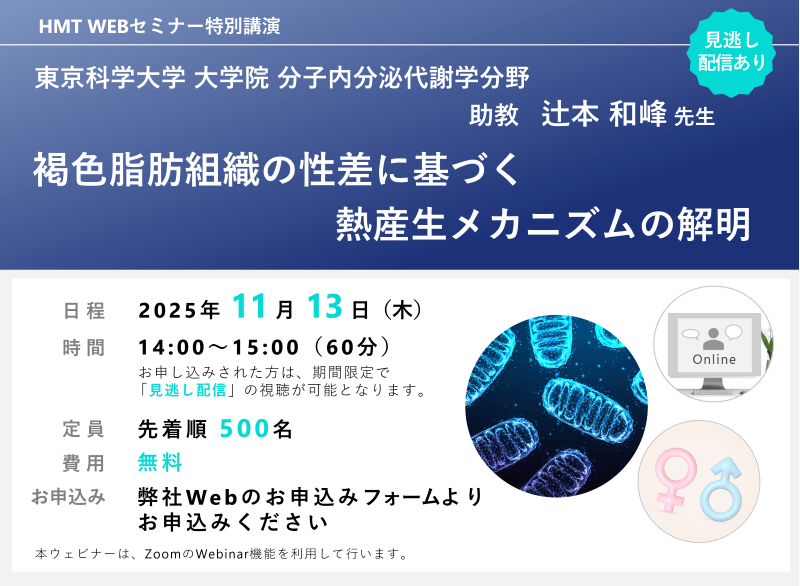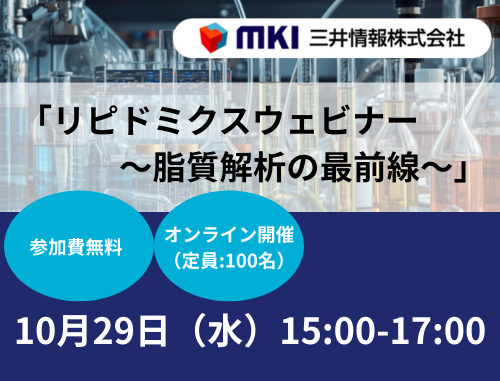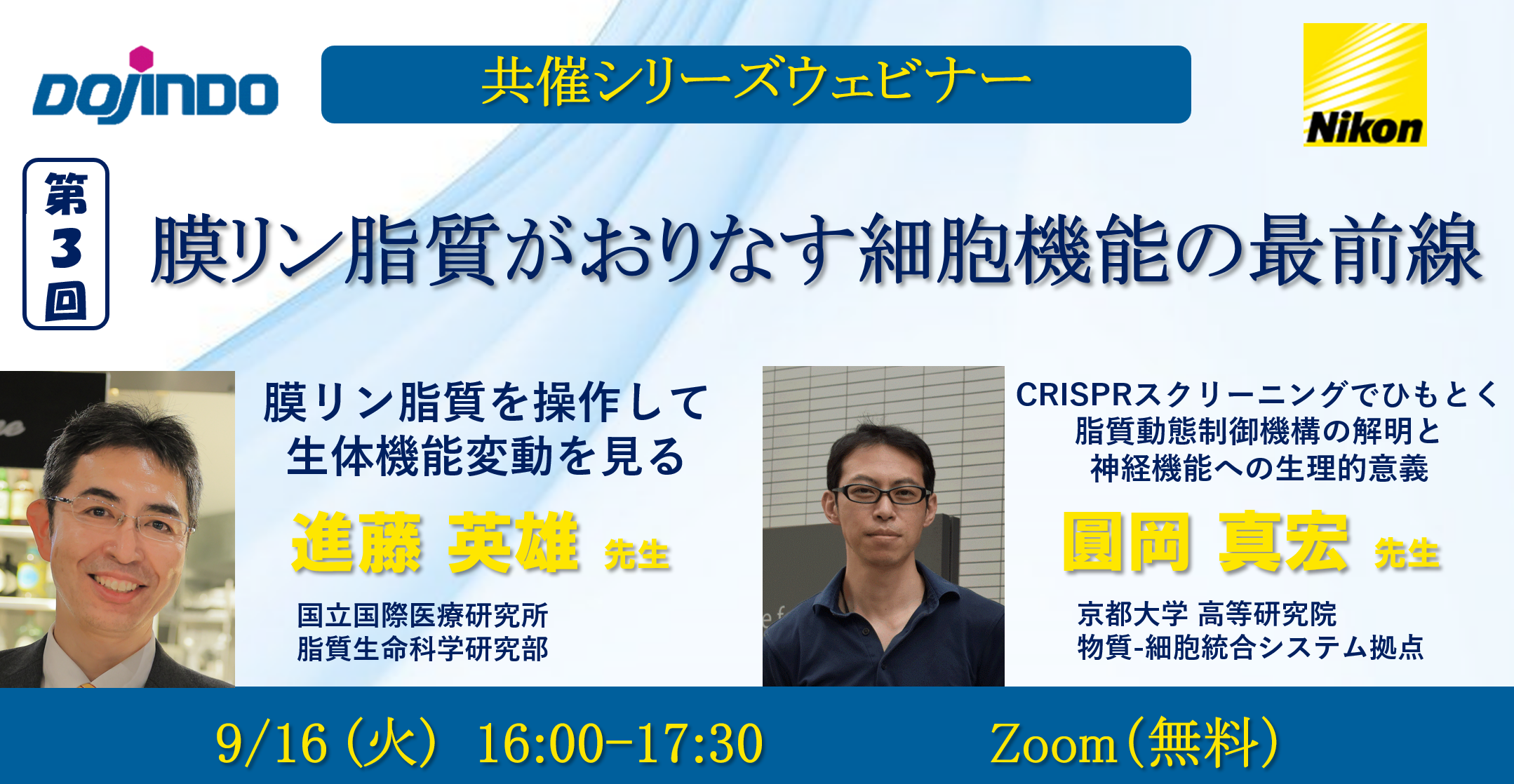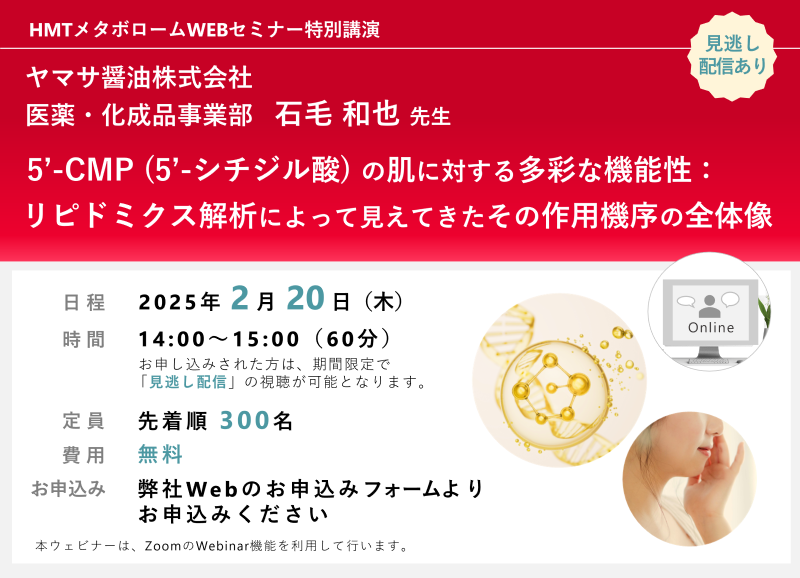LINK-J & UCサンディエゴ ジョイントウェビナーシリーズ 第10回 with 神戸大学
UCサンディエゴと神戸大学は何年にもわたり生命科学、計算機科学、構造工学の分野で共同研究を進めてきました。特に両校が強みを持つ生物学、生化学における脂質研究は、双方の研究者が重点的に協力してきた分野です。今回新たに開始する「細胞内シグナル伝達と脂質研究」ジョイントウェビナーシリーズでは、UCサンディエゴのセルシグナリングセンターと神戸大学のバイオシグナル総合研究センター及びメディカルトランスフォーメーション研究センターの研究者が最新の研究成果をご紹介します。細胞質膜の脂質組成やタンパク質との相互作用は、細胞の移動だけでなく、細胞分化やアポトーシスにも密接に関連しています。そこで、最初のセッションでは、両校の教授が細胞膜脂質の機能研究に有用な最新のバイオコンジュゲーション法や膜結合タンパク質の重要性について論じます。
※使用言語:英語
※同時通訳あり
※英語字幕利用可能(オン/オフは自由に選択できます)
※字幕は市販されているアプリを使用しており、LINK-JおよびUC San Diego、神戸大学は誤訳、訳文の欠落など、字幕に関する一切の責任は負えませんので、ご了解願います
字幕利用方法:クローズドキャプションの管理と表示
◆前回までのUCサンディエゴに関するイベントやレポートはこちらをご覧ください
日時: 2022年9月7日(水)9:00-10:15(日本時間)
オンライン(Zoomウェビナー)
参加方法
Peatixから申し込む
本イベントにはZoomウェビナーを使用します。事前にPeatixにて参加登録をお済ませください。
・参加申込後の視聴ページに参加URL・パスワードを掲載しておりますので、ご確認いただき、視聴時間になりましたら「チケット表示」→「イベントに参加」ボタンよりお入りください。(専用URLとなりますので、他者との共有はお控えください)
・ウェビナーの操作方法等はご自身で事前にご確認をお願いいたします。
プログラム
| 日本時間 | 内容 |
| 9:00-9:02 | Welcome - Akihiko Soyama, LINK-J and Miwako Waga, UC San Diego |
| 9:02-9:03 | Brief Remarks - Dr. Yasuhito Shirai, Professor, Graduate School of Agricultural Science, Kobe University |
| 9:03-9:05 | Brief Remarks and Speaker Introduction - Dr. Itay Budin, Assistant Professor of Chemistry and Biochemistry, UC San Diego |
| 9:05-9:30 | Presentation - "Bioconjugation strategies for revealing the roles of lipids in living cells" Dr. Neal K. Devaraj, Professor of Chemistry and Biochemistry, UC San Diego |
| 9:30-9:35 | Q&A - moderated by Dr. Budin |
| 9:35 | Speaker introduction - Dr. Shirai |
| 9:35-10:00 | Presentation - "Membrane tension and membrane-bending proteins in the regulation of cell migration" Dr. Toshiki Itoh, Professor, Biosignal Research Center, Kobe University |
| 10:00-10:14 | Q&A and Discussion - moderated by Drs. Shirai & Budin |
| 10:14-10:15 | Closing Remarks - A. Soyama |
アブストラクト
Devaraj先生ご講演
"Bioconjugation strategies for revealing the roles of lipids in living cells"
Our laboratory developed and applied different bioconjugation strategies to study the role of lipids and lipid modifications in cells. Inspired by our ongoing work on developing lipid bioconjugation strategies to generate artificial cell membranes, we developed a ceramide synthesis method in live cells using a salicylaldehyde ester that readily reacts with sphingosine in form of a traceless ceramide ligation. Our study not only confirmed existing knowledge about the association of ceramides with cell death, but also gave interesting new findings about the structure-function relationship of ceramides in apoptosis. Our initial efforts led us to investigate probes that detect endogenous sphingolipids using live cell imaging. We describe the development of a fluorogenic probe that reacts chemoselectively with sphingosine in living cells, enabling the detection of elevated endogenous levels of this biomarker in human disease. Building on our interest in the fluorescence labeling of lipids, we have also explored the use of bioorthogonal reactions to label chemically synthesized lipid probes. I will discuss the development of photocaged dihydrotetrazine lipids, where the initiation of the bioorthogonal reaction can be triggered by visible light, allowing for live cell modification of membranes with spatiotemporal control.
伊藤先生ご講演
"Membrane tension and membrane-bending proteins in the regulation of cell migration"
Cells are not simply spherical in shape, but have a variety of shapes according to their functions. When we draw a picture of a cell on paper, the outline usually corresponds to the cell membrane. In other words, the basis of the diversity of cell morphology is the mechanism that controls the shape of the cell membrane. The plasma membrane is subjected to a physical force called membrane tension, which is the sum of (1) the planar tension that pulls the lipid bilayer horizontally and (2) the adhesive force between the plasma membrane and cortical actin. The former is thought to be contributed mainly by the osmotic pressure difference between the inside and outside of the cell, while the latter is thought to be contributed mainly by the interaction between plasma membrane phospholipids and actin-binding proteins. We have identified the F-BAR domain, a conserved region with membrane-deforming activity, and are analyzing its physiological function. The F-BAR domain is conserved in FBP17, which activates the actin polymerization factor N-WASP-Arp2/3, Slit-Robo GAPs (srGAPs), which are RhoGAPs, and Fer and Fes, which are tyrosine kinases. Therefore, F-BAR domain-containing proteins are thought to functionally link actin polymerization to the shape of the plasma membrane. However, the specific mechanism of how the membrane deformation activity of the F-BAR domain regulates actin polymerization in cancer cell invasion and other processes has remained unclear. We recently found that the membrane deformation activity of the F-BAR domain functions as a sensor of plasma membrane "bendability," or membrane tension. Actin polymerization increases plasma membrane tension, and increased membrane tension causes F-BAR domain proteins to dissociate from the plasma membrane. Thus, the parameter of plasma membrane shape provides a scaffold for actin polymerization and may also regulate cell motility through a feedback mechanism mediated by membrane tension.
登壇者略歴
Dr. Yasuhito Shirai, Professor, Graduate School of Agricultural Science, Kobe University
Yasuhito Shirai is a Professor and Vice Dean of the Graduate School of Agricultural Science at Kobe University. He also serves as the Director of Americas Division in the Institute for Promoting International Partnership.
Shirai earned his PhD in 1994 in the Graduate School of Agricultural Science, Kobe University. He became an Assistant Professor in the Graduate School of Science and Technology and then in the Biosignal Research Center (BSRC). While he was assistant professor at BSRC, he worked as a visiting scholar at the University California San Diego in 2000-2001. He was promoted to an Associate Professor in the BSRC and obtained a second PhD degree from the School of Medicine of Kobe University in 2005. Finally, he was promoted to a Professor in the Laboratory of Chemistry and Utilization of Animal Production Resources in the Department of Agrobioscience, Graduate School of Agricultural Science. He conducts signal transduction research focusing PKC and DGK to develop functional food, medical food, and medicine.
Dr. Itay Budin, Assistant Professor of Chemistry and Biochemistry, UC San Diego
Itay Budin is an Assistant Professor in the Departments of Chemistry & Biochemistry and Bioengineering at UC San Diego. Trained as a biophysicist, his lab investigates the interplay between lipid chemistry and cell membrane function. Dr. Budin received his PhD from Harvard University and carried out postdoctoral studies as a Miller Fellow at UC Berkeley. He is the recipient of the Walter Shaw Young Investigator Award in lipid biology from the American Society for Biochemistry and Molecular Biology and early career awards from the National Science Foundation and US Department of Energy.
Dr. Neal K. Devaraj, Professor of Chemistry and Biochemistry, UC San Diego
Neal Devaraj is a Professor of Chemistry and Biochemistry and the Murray Goodman Endowed Chair in Chemistry and Biochemistry at the University of California San Diego (UC San Diego). A native of Southern California, he attended college at the Massachusetts Institute of Technology where he performed research in the lab of Prof. Moungi Bawendi. He earned his PhD in Chemistry at Stanford University in the labs of Profs. James Collman and Christopher Chidsey. After a postdoctoral fellowship at the Harvard Medical School in the lab of Prof. Ralph Weissleder, he joined UC San Diego. His research interests are in artificial cells, lipid membranes, and bioconjugation.
Most recently, he has been named a Vannevar Bush Faculty Fellow by the Department of Defense (DOD). He was one of only nine selected fellows, and the first from UC San Diego since 2015. He was recognized for his proposed work on “engineering dynamic lipid compartments for an artificial cell.”
Dr. Toshiki Itoh, Professor, Biosignal Research Center, Kobe University
Toshiki Itoh graduated from the Faculty of Science at the University of Tokyo and completed his graduate studies in the laboratory of Professor Tadaomi Takenawa. In Takenawa's lab, he was involved in the discovery and functional analysis of phosphoinositide kinases/phosphatases and phosphoinositide-binding proteins. After obtaining his PhD, he was a postdoctoral fellow in the laboratory of Professor Pietro De Camilli at Yale University, where he discovered the F-BAR domain. After returning to Japan, he worked as an associate professor at the Institute of Medical Science, the University of Tokyo, and then as an associate professor at the Graduate School of Medicine, Kobe University before becoming a professor at the Biosignal Research Center, Kobe University. His research interests include the regulation of membrane shape and the mechanisms of cellular function by membrane mechanics.
参加費
無料(要事前登録)

